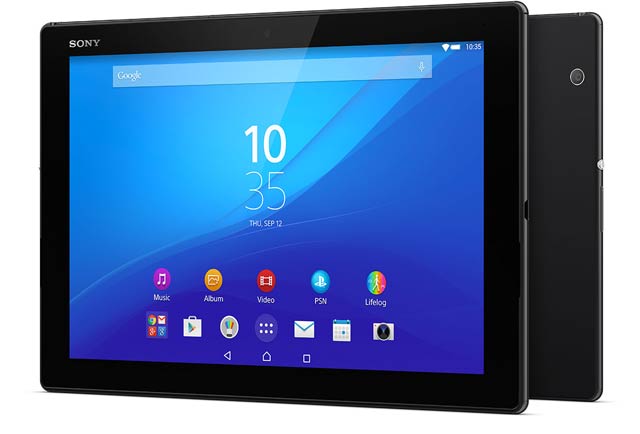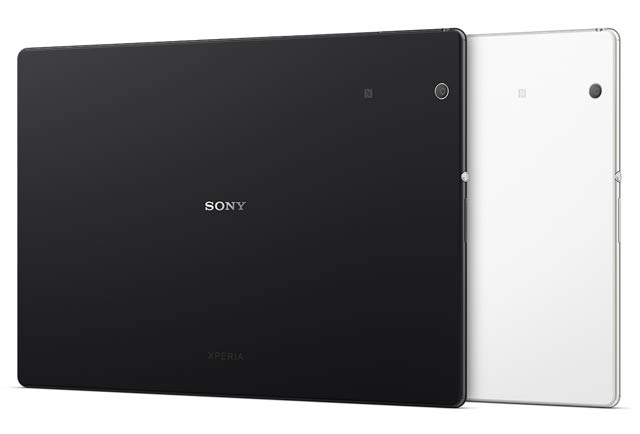
What do you do if your rival’s product is both market leading and market defining? When everything you do will be compared to your competitor’s offering? Well, if you’re Sony and you’re making a tablet computer, and your competitor is the iconic iPad, it’s simple: you engineer a device that is even thinner, even lighter and just as snappy.
Sony is probably the only company in the world that could have built the new Xperia Z4 Tablet, which is so thin that a pencil held to its edge obscures it from view. At 6,1mm, it’s the same thickness as the already incredibly thin iPad Air 2, but Sony’s tablet is noticeably lighter. At 392g, it bests the Air 2 by a significant 45g. Take that, Cupertino!
Apple’s tablet was already a feat of engineering. That Sony’s managed to go even further is quite something.
But consumers don’t just choose tablets based on their thickness and their weight. Does the Z4 Tablet best the iPad Air 2 in other departments?
That depends on what you’re looking for.
In design, the Sony is easily the iPad’s match. With a beautiful waterproof (yes, waterproof!) shell and a bezel that’s been reduced noticeably in size over its predecessor, the Sony stands testament to the fact that simplicity in technology product design works well.
The left edge of the device has the power/sleep/wake button and a volume rocker. The right edge has only the micro USB charging port, which is waterproofed, even though it doesn’t have a flap (another improvement over past Xperia Z tablets). The top edge has a flap that houses the Sim card slot and a microSD card slot (with cards of up to 128GB in size accepted — a pity it’s not 256GB). There’s also a well-placed 3,5mm audio jack at the top left.

Rounding out the tablet’s exterior are two cameras. The rear-facing unit is an 8,1-megapixel affair — why not the stunning 20-megapixel sensor in the Xperia Z3 smartphone, Sony? — and the front-facing one is five megapixels, which is sufficient to do video calls at 1080p resolution.
The rear of the device, which has a matte black plastic finish with an unusual feel to it, might prove controversial. We received mixed feedback when we asked people for their opinions, with some saying it should have been glass, although your reviewer quite likes the matte finish. Also, glass would have been more slippery, and the last thing you want to do is drop this gorgeous computer onto the floor.
What’s inside counts just as much, if not more, than what’s on the outside (the same applies to human beings, apparently). And despite its weight and slim size, Sony has packed in a powerhouse of hardware.
Let’s start with connectivity. Mobile broadband is via a 300Mbit/s Cat 6 4G/LTE antenna (no Telkom 2,3GHz band support, though). There’s legacy 3G and 2G as well, plus Wi-Fi up to the ac variant with dual-band support for even speedier access. DLNA is included for sharing multimedia with television sets and other compatible devices.

Assisted GPS and Glonass (the Russian GPS) are built in, as is near-field communication (useful for pairing speakers and other devices) and, interestingly, ANT+, the communication standard favoured by GPS sports watch makers.
The Z4 Tablet’s 2GHz Snapdragon octa-core processor is paired with a generous 3GB of RAM (enough for most modern Android apps). There’s also 32GB of flash storage, which could prove limiting for anyone planning to use the tablet as a laptop replacement, though here the microSD card slot could come in useful. Now that Microsoft Office apps like Word and Excel are available on Android, more people will consider the platform for business use.
The 10,1-inch display has a resolution of 2 560×1 600 pixels and has scratch-resistant glass (we didn’t test this claim as our review unit had to be returned) and an anti-fingerprint coating. The coating helped reduce the worst marks, but the tablet still ended up full of smudges after a few hours of use.
Given its size, the speakers are quite good, too, mimicking surround sound and using sound improvement software. They’re still a bit tinny, though — something plugging in a pair of good-quality headphones quickly resolves.
The tablet’s 6 000mAh battery is decent, too. Sony has done excellent work with its implementation of Android, ensuring battery drain is kept to an absolute minimum. The Z3 and Z3 Compact smartphones, for example, are class-leading when it comes to battery life.
So, is the Z4 Tablet worth getting over the iPad? The answer to that will probably come down to two things.
Firstly, does Android have the apps you’d want to use? A few years ago, the iPad had an unassailable lead over Android tablets in this regard, but that’s changed substantially since then. The addition of Word, Excel and PowerPoint to Android makes the platform more of a business tool.
Secondly, and probably more importantly, is price. And here the Sony doesn’t do as well. At R10 999 (without accessories), the 32GB Z4 Tablet is R300 more expensive than the 64GB iPad Air 2. That’s a big price to pay for 45g less weight. For this reason alone, the Z4 Tablet isn’t likely to do any real damage to Apple’s market share.
Still, the Z4 is a fantastic device, and if the extra cash isn’t an issue or if Android is a must, this is without doubt one of the best high-end tablets money today can buy. — © 2015 NewsCentral Media

